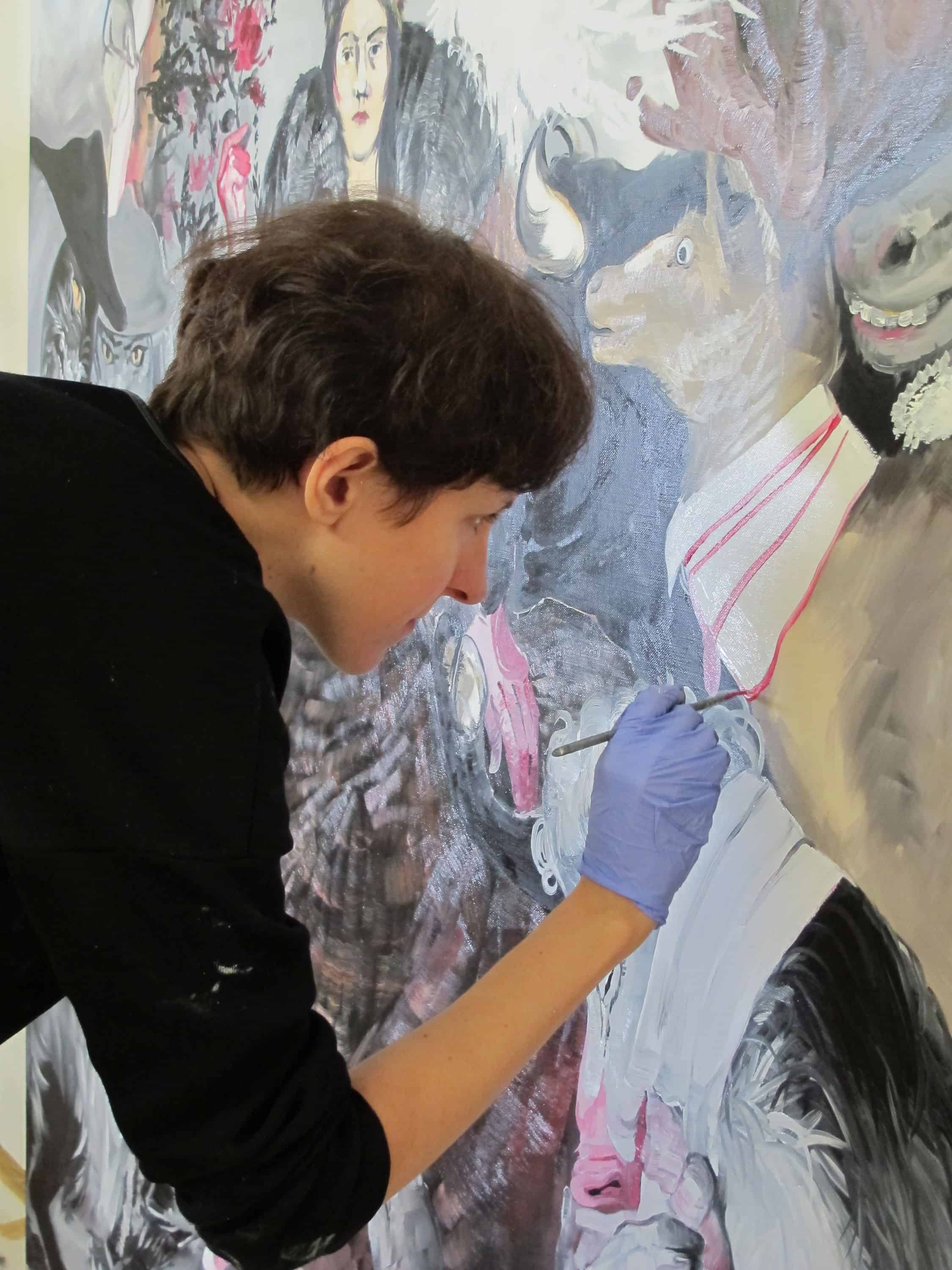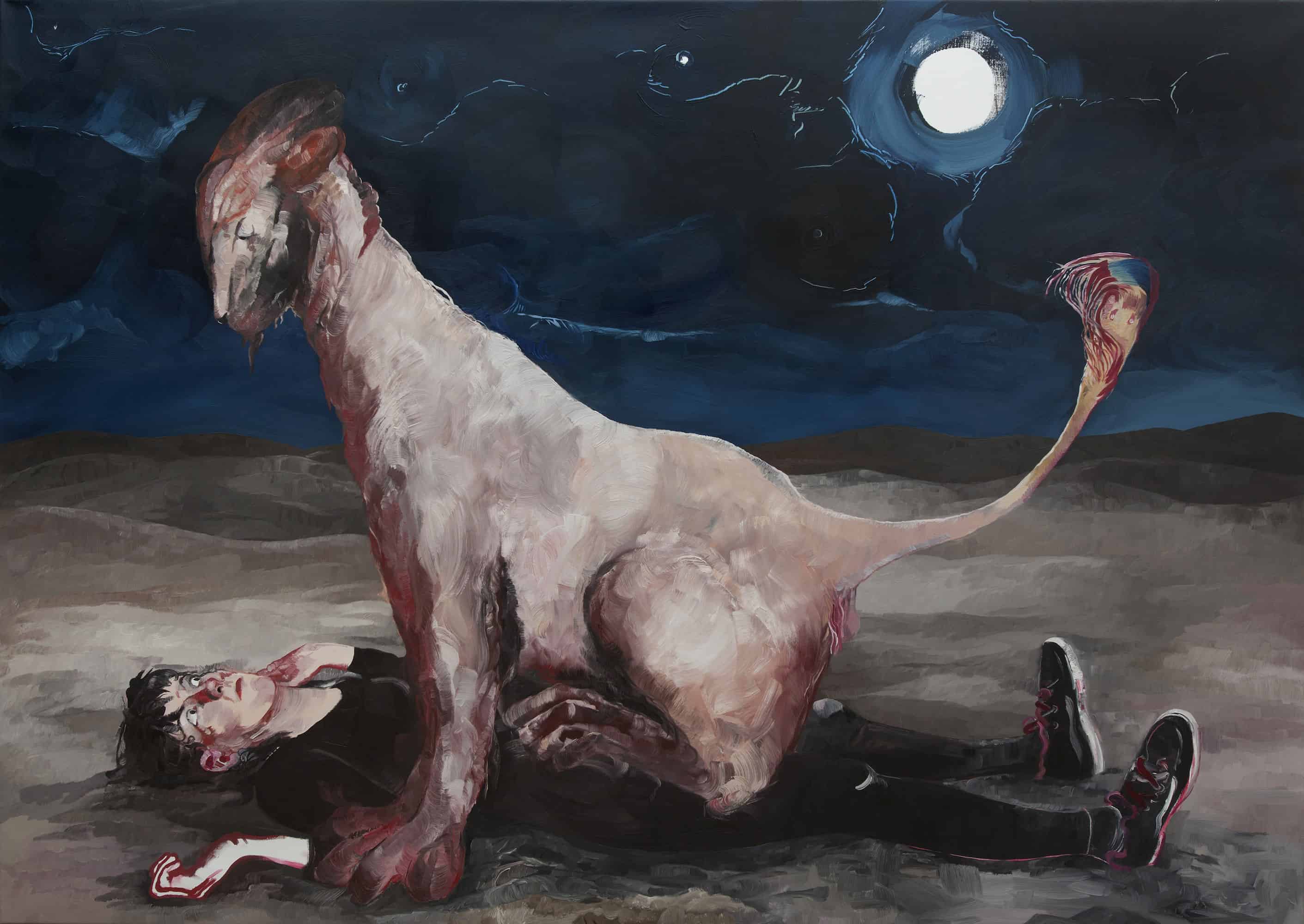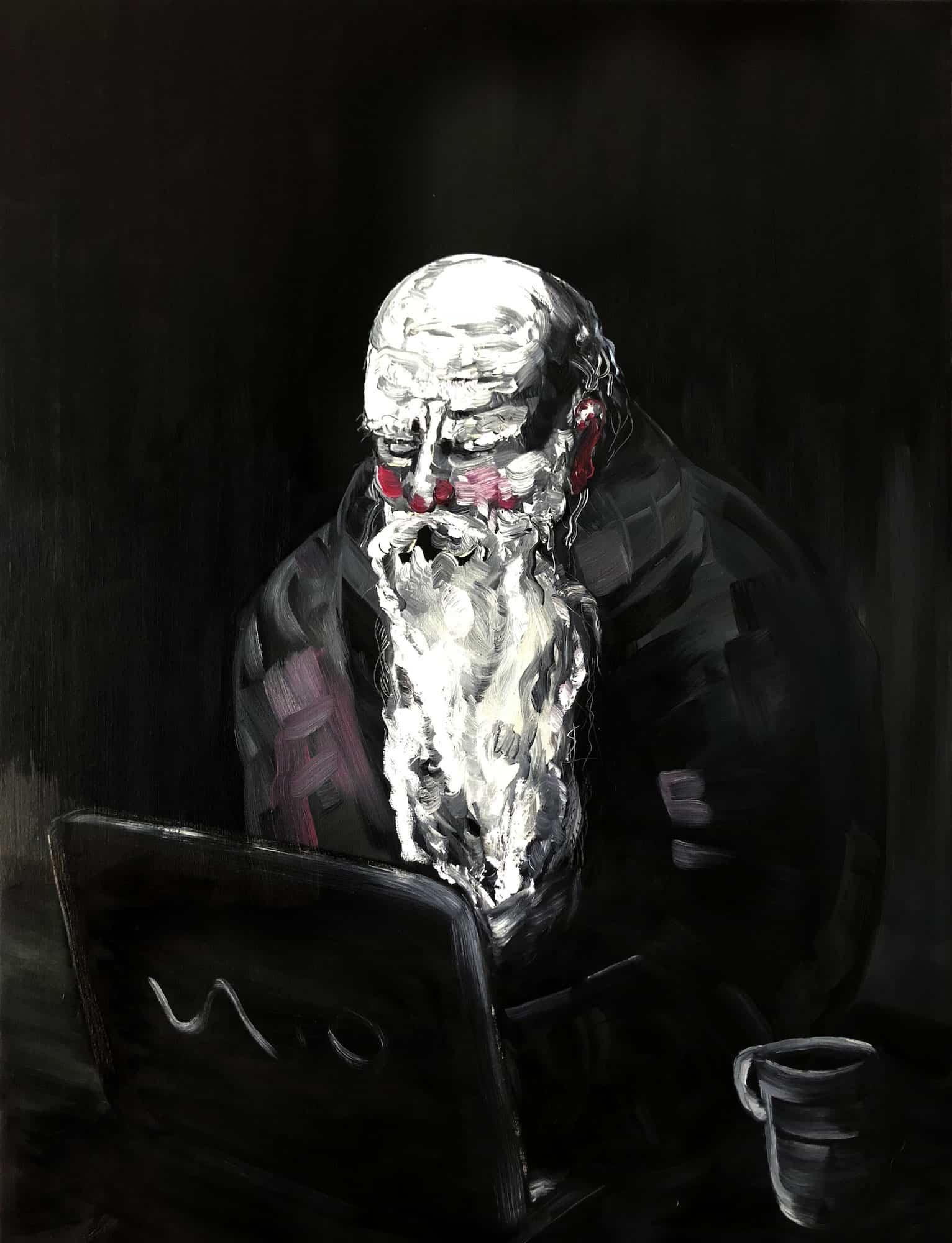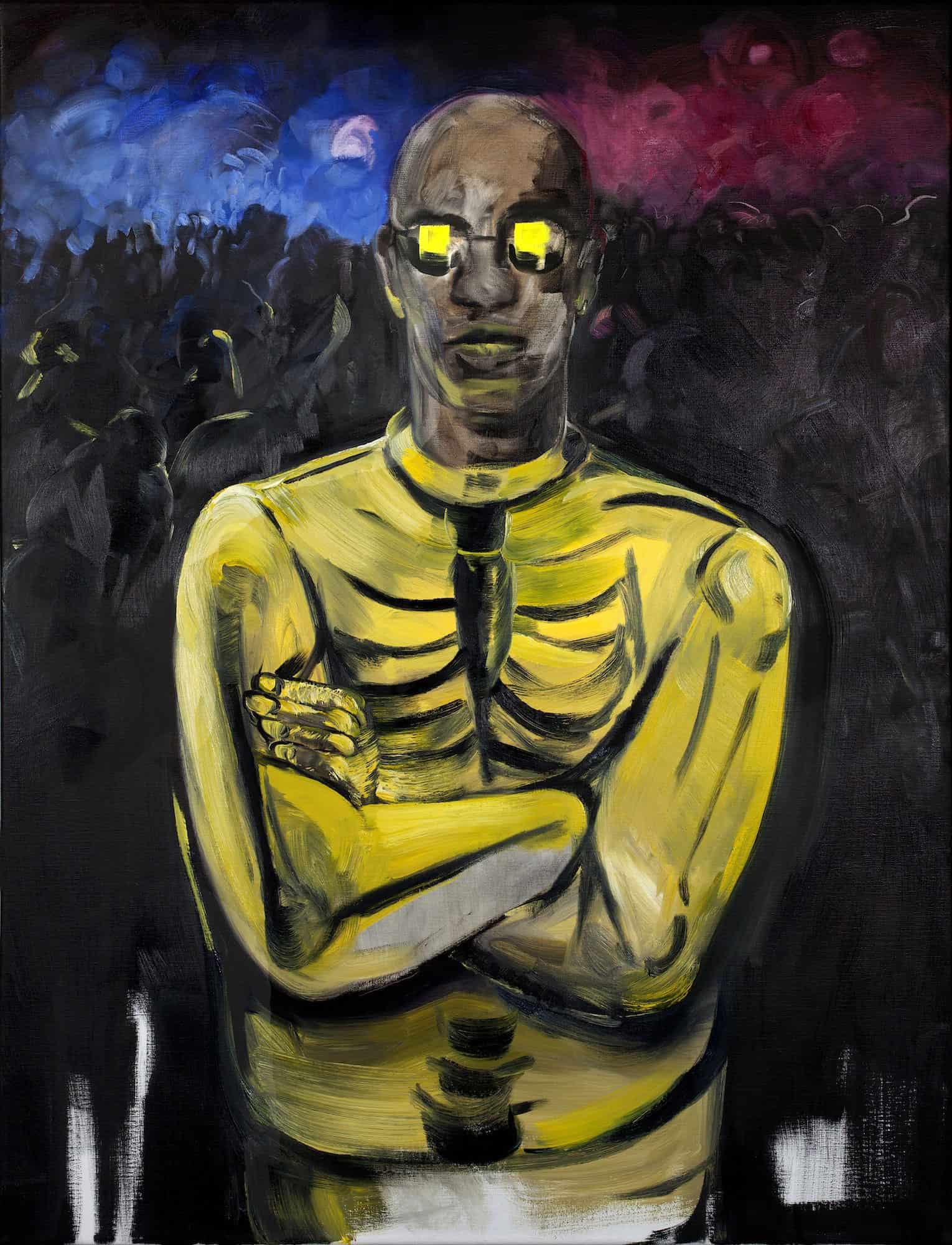This month, I’ve met with Pola Dwurnik to discuss her latest series of paintings, “Apolonia’s Twelve Husbands”. The series will be shown as part of the upcoming Warsaw Gallery Weekend, at the exhibition organised by Krupa Gallery from Wrocław.
I’m meeting Pola in her studio located right in the centre of Warsaw. She waits for me in the corridor and as soon as we enter the space, I can smell turpentine. Paintings occupy almost the whole flat. There are the big ones and the smaller ones, the ones that Pola has finished already, and the ones that will be finished “when she finds the time”. She must be really busy, I’m thinking, when she tells me about all the projects she is working on, has finished or had not yet started.

Pola Dwurnik in her company, photo: Teresa Gierzynska
Maria Markiewicz: I’d like to start our conversation with “Apolonia’s Garden.” In this series you depict your ex-partners as animals. Are there any other connections, in addition to autobiographic elements, between “Apolonia’s Garden” and “Apolonia’s Twelve Husbands” series of paintings we will be able to see in September?
Pola Dwurnik: Both series demonstrate a similar outlook on interpersonal relations. It is extremely difficult to depict such a complicated emotional and physical relationship with another human being in a single painting, but I’m trying. In my paintings, I’m attempting to discuss a complex subject matter in very simple terms.
MM: While at the same time you arrange your paintings in series … What is your inspiration?
PD: “Apolonia’s Garden” was a collection of eight paintings, each showing a distinct relationship. They somehow arranged into a series themselves. Eight animals – eight men to be exact – that I’ve dated over the period of 15 years. From the first one to the most recent one. I was inspired by an old well-established way of presenting people, their virtues and vices, with the use of animal figures. At the same time, what the series refers to most of all is the story of the sorceress Alcina, a character from the sixth canto of “Orlando Furioso” by Ludovico Ariosto.
Pola Dwurnik, January, oil on canvas, 116x89cm
Pola Dwurnik, February, oil on canvas, 116x89cm
MM: And “Apolonia’s Twelve Husbands” series?
PD: These paintings also make up a series; it follows 12 months, one year in total, at the same time depicting 12 stages of human life, from youth to old age. While working on the paintings I used pieces of my life, my experiences, and my observations of other people. The paintings form a circle; the whole series is, in fact, a circle. “January” is a young boy with a backpack standing against a background of a mountainous landscape. A similar boy can be found in “December”, this time taking on the role of a male nurse accompanying a dying old man. After he leaves the bedside of this dying man, he will take off his white lab gown, put on his backpack and head for the mountains. Then we have “January” again, bright and careless.
MM: What are the differences between the two series?
PD: In “Apolonia’s Garden” I painted specific people, each painting’s title includes a name of a man whose story is being told, and they are real names. In contrast, my most recent series is composed of portraits of fictional characters. They are compilations of various people and experiences, mine and other’s, because I haven’t reached the “December” of my life yet. “Apolonia’s Garden” is a gallery of animal portraits, and here, there are simply portraits. Previous series had uniform stylistics, one method of applying oil paint and one portraying method. In “Apolonia’s Twelve Husbands” the paintings are more diversified form-wise. The time span of working on the paintings is also different – I took me 2 years to paint the “Garden…” and 5 years to finish “Twelve Husbands.”
MM: So, the characters are fictional in “Apolonia’s Twelve Husbands,” but they often remind me of someone…
PD: “January” is a young boy with a hamster on his shoulder. This thread goes all the way back to my early childhood. In pre-school, when I was 6, I fell in love with a blonde boy from another grade, and then in primary school, I was head over heels for another blonde boy, this time from my grade. Of course, most children had a hamster or a guinea pig at home. Also, this character has features of a Ukrainian actor Vasili Vasylyk who resembles those two boys, these children who were my first puppy loves. So, I portrayed three people in the figure of “January.”
“February” on the other hand is a heavy metal enthusiast who’s wearing a black leather coat and holding a microphone, and this is a portrait of Alice Cooper, Steven Tyler and young Ozzy Osbourne. At the same time, this painting is a recollection of my two friends, one from secondary school and the other from university. They both had long hair, listened to goth music, and fascinated me. At the same time “February” marks the beginning of life’s hardships, the melting snow is no longer white, it is dirty.
MM: And do you have a favourite painting in this series?
PD: Oh, this is a tough one. I painted the series for a long time. The first painting – “May” portrait – was created in 2014. This “May” husband is Bruce Wayne in the outstanding interior designed by Zaha Hadid. I remember that I was overjoyed when I came up with the idea for this series, and I remember the excitement I felt as I painted my first work. I still feel a very strong surge of adrenaline when I look at “May.” But this is not my favourite painting of the series. I am very fond of “September”, because I am satisfied with the outcome. It is difficult to paint a portrait of a fifty-year-old, which has a clear message but is not kitschy. The character from this painting is a fifty-year-old story-teller who takes his wife to Rome, and is telling the history of the Eternal City over a glass of good red wine.
Pola Dwurnik, November, oil on canvas, 116x89cm
Pola Dwurnik, October, oil on canvas, 116x89cm
MM: Let’s leave these two series for a while. In one of your interviews, you said that that a woman figure was the main protagonist of your paintings. Looking at your most recent series, I think that something has changed in this respect.
PD: In my opinion, the protagonist of “Apolonia’s Twelve Husbands” is also a woman – a heterosexual woman who looks at men in a very specific way, since she sees in them life partners, hence the “husband” figure. After I created “Apolonia’s Garden”, some men accused me of treating them as objects, of “reducing” them to animals. It is an absurd accusation, of course, because we are dealing with a series of paintings as a purely artistic gesture, a simplification inspired by La Fontaine’s fables. But speaking of objective or subjective treatment, I took a more “object-oriented” approach in “Twelve Husbands” because I created allegories out of people’s portraits (allegories of 12 months). I am the subject speaking my mind here – as the author and as a woman.
MM: In one of your interviews you said that you didn’t like when people interpreted your art from the perspective of feminism. But in my opinion, your works are extremely feminist. Let’s take “The Painter” as an example…
PD: I am a feminist in my private life, and what I meant to say was that that’s not the only possible way to read my works, not the only right one. But yes, “The Painter” is a very feminist painting, and that is why it was exhibited in Zalipie, among the works of amateur female painters who create decorative floral motifs on houses and everyday household objects. Our presence in Zalipie, the painting’s and mine, as a conscious and emancipated subject, was to draw the viewers’ attention to the absence and invisibility of female painters as subjects who speak their mind, as political and critical entities.
Together with the BWA Gallery in Tarnów, we issued “The Painter” on a postcard, to disseminate it in this political context. Feminist art in Poland is not usually associated with painting, and we wanted to change that. At the same time, this painting talks about fear related to my coming out as a woman-painter, a daughter of an another outstanding man-painter. At the time (2007) I was often compared to my father and perceived as the inferior one. It doesn’t happen that often these days. Besides, I have changed, and I am not hiding under a rock anymore. It is pointless to compare me and my father, and my oeuvre to his oeuvre, because my dad was an extremely prolific artist. He was very strong physically and he could paint one or two paintings a day. I’m not that fast. In this sense, I could not be a match for him.

Pola Dwurnik, June, oil on canvas, 116x89cm
MM: It’s true, you work in a totally different way…
PD: Totally different, yes. I think a lot about each painting. I take lots of notes, I make detailed research, I collect photos and make sketches. It often takes me a few years to plan a single painting! And my dad just painted from dawn till dusk, creating his painting around loose associations, various fast connotations; he painted impatiently and voraciously. He was able to do that, because he had an agile mind, and could find associations between a lot of things in such a way that it somehow always made sense. I prepare everything first, celebrating the whole process that way. It doesn’t matter that viewers might not read or notice everything. What matters to me is that I create everything eagerly and with precision, because I love to do it. To me, painting is celebration of life. My slowly progressing career reflects that – I do not make hundreds of paintings for six different galleries.
MM: You are usually asked about your father, Edward Dwurnik, and since we have already mentioned him, I’d like to ask about your mum, Teresa Gierzyńska. Has she also had any influence on you, as the artist that you are today?
PD: Yes, she had a huge influence on me, because she taught me, like a true sculptor, how to properly paint an arm, a face, a humanbody. She placed the emphasis on avoiding errors or simplifications which result from insufficient technical skills or lack of knowledge on anatomy. She also taught me how to think in a conceptual way, which is something my dad never educated me on. I think that the fact that I’ve been painting myself for years, that I’ve been painting self-portraits, also comes from my mother. Though I’ve been doing this in a totally different way than she did. Come to think of it, I have combined the artistic practices of both my parents in my works. Teresa creates modest and subtle works, uses small formats, her works are sophisticated in terms of style, but at the same time minimalistic. My father’s works are just the opposite. I draw from his lavishness and abundance of forms and colours. At the same time, I draw from my mother’s reflectiveness, her tender insight into herself as a woman, into emotions, experiences, fears and traumas.

Pola Dwurnik, December, oil on canvas, 116x89cm
MM: You paint yourself, because there is nobody else you know better.
PD: Paintings come to me; they are displayed in my head. They come from the inside, from my mind, from memories mixed with dreams; from a desire or some kind of powerlessness, often helplessness. They stem from my problems, sadness and sorrows. The same can be observed in Teresa’s works, while my father was very detached and distanced from himself. We don’t really know what he actually experienced. He would hide himself inside his paintings, in the theatre of figures, cities, buildings, and themes. In my art, I try to stay very close to myself, and art is often a form of therapy in my life. “The Painter” we’ve mentioned before was a type of therapy. After I painted her, I stopped hiding in the bushes…

Pola Dwurnik, Suprise, oil on canvas, 150×210, 2016











